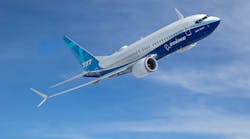The Federal Aviation Administration listed the design changes it will require for the grounded Boeing 737 MAX aircraft before it will issue an Airworthiness Directive that will allow airlines to resume operating the twin-engine jets. The changes are presented in a "Notice of Proposed Rulemaking (NPRM) for an Airworthiness Directive (AD)" delivered to the Office of the Federal Register, reaffirming FAA's promise to initiated a 45-day public-comment period for assessing the changes.
The public comment period will begin once the NPRM is published in the Federal Register.
The changes FAA will require include installing a new flight-control software to correct problems with the 737 MAX's previous Maneuvering Characteristics Augmentation System (MCAS), which has been identified as the primary cause of two fatal crashes of 737 MAX jets in October 2018 and March 2019.
Other changes include revising the Airplane Flight Manual to reflect new and revised procedures for 737 MAX flight crews; installing a new 737 MAX display system software; and changing the horizontal stabilizer trim wire-routing installations.
FAA also will require 737 MAX operators to conduct tests of the aircraft's angle-of-attack sensor system and perform an operational readiness flight prior to returning each airplane to service.
The changes listed in the NPRM do not include proposed new requirements for pilot training, which FAA will publish later. ”Pilot training will be evaluated by the Joint Operations Evaluation Board (JOEB) and the FAA’s Flight Standardization Board (FSB),” according to FAA.
The 737 MAX is a twin-engine narrow-body aircraft that entered into commercial service in 2017. After the series was grounded worldwide in March 2019, Boeing revised the MCAS and identified the needed changes to the 737 MAX display system software and the horizontal stabilizer trim wire routing.
Test flights of the redesigned 737 MAX were conducted by Boeing and FAA pilots in early July.





